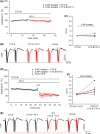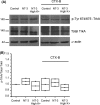Neurotrophin-3 restores synaptic plasticity in the striatum of a mouse model of Huntington's disease
- PMID: 29453932
- PMCID: PMC6489824
- DOI: 10.1111/cns.12824
Neurotrophin-3 restores synaptic plasticity in the striatum of a mouse model of Huntington's disease
Abstract
Aims: Neurotrophin-3 (NT-3) is expressed in the mouse striatum; however, it is not clear the NT-3 role in striatal physiology. The expression levels of mRNAs and immune localization of the NT-3 protein and its receptor TrkC are altered in the striatum following damage induced by an in vivo treatment with 3-nitropropionic acid (3-NP), a mitochondrial toxin used to mimic the histopathological hallmarks of Huntington's disease (HD). The aim of this study was to evaluate the role of NT-3 on corticostriatal synaptic transmission and its plasticity in both the control and damaged striatum.
Methods: Corticostriatal population spikes were electrophysiologically recorded and striatal synaptic plasticity was induced by high-frequency stimulation. Further, the phosphorylation status of Trk receptors was tested under conditions that imitated electrophysiological experiments.
Results: NT-3 modulates both synaptic transmission and plasticity in the striatum; nonetheless, synaptic plasticity was modified by the 3-NP treatment, where instead of producing striatal long-term depression (LTD), long-term potentiation (LTP) was obtained. Moreover, the administration of NT-3 in the recording bath restored the plasticity observed under control conditions (LTD) in this model of striatal degeneration.
Conclusion: NT-3 modulates corticostriatal transmission through TrkB stimulation and restores striatal LTD by signaling through its TrkC receptor.
Keywords: Huntington's disease; NT-3; TrkC; neurodegeneration; neurotrophins.
© 2018 John Wiley & Sons Ltd.
Conflict of interest statement
The authors declare no conflict of interest.
Figures







Similar articles
-
Neurotrophin-3 Rescues Striatal Synaptic Plasticity in Model of Neurodegeneration by PLC Signaling Activation.CNS Neurol Disord Drug Targets. 2024;23(12):1488-1498. doi: 10.2174/0118715273298919240531110022. CNS Neurol Disord Drug Targets. 2024. PMID: 38859788
-
In vivo mitochondrial inhibition alters corticostriatal synaptic function and the modulatory effects of neurotrophins.Neuroscience. 2014 Nov 7;280:156-70. doi: 10.1016/j.neuroscience.2014.09.018. Epub 2014 Sep 18. Neuroscience. 2014. PMID: 25241069
-
Do BDNF and NT-4/5 exert synergistic or occlusive effects on corticostriatal transmission in a male mouse model of Huntington's disease?J Neurosci Res. 2019 Dec;97(12):1665-1677. doi: 10.1002/jnr.24507. Epub 2019 Aug 7. J Neurosci Res. 2019. PMID: 31392756
-
The corticostriatal projection: from synaptic plasticity to dysfunctions of the basal ganglia.Trends Neurosci. 1996 Jan;19(1):19-24. doi: 10.1016/0166-2236(96)81862-5. Trends Neurosci. 1996. PMID: 8787136 Review.
-
Neurotrophin-dependent modulation of glutamatergic synaptic transmission in the mammalian CNS.Gen Pharmacol. 1998 Nov;31(5):667-74. doi: 10.1016/s0306-3623(98)00190-6. Gen Pharmacol. 1998. PMID: 9809461 Review.
Cited by
-
Huntington's disease: From basic science to therapeutics.CNS Neurosci Ther. 2018 Apr;24(4):247-249. doi: 10.1111/cns.12841. CNS Neurosci Ther. 2018. PMID: 29582586 Free PMC article. No abstract available.
-
Neurotrophin-3 Rescues Striatal Synaptic Plasticity in Model of Neurodegeneration by PLC Signaling Activation.CNS Neurol Disord Drug Targets. 2024;23(12):1488-1498. doi: 10.2174/0118715273298919240531110022. CNS Neurol Disord Drug Targets. 2024. PMID: 38859788
-
Human striatal progenitor cells that contain inducible safeguards and overexpress BDNF rescue Huntington's disease phenotypes.Mol Ther Methods Clin Dev. 2025 Jan 22;33(1):101415. doi: 10.1016/j.omtm.2025.101415. eCollection 2025 Mar 13. Mol Ther Methods Clin Dev. 2025. PMID: 39995448 Free PMC article.
-
Molecular Regulatory Mechanism and Toxicology of Neurodegenerative Processes in MPTP/Probenecid-Induced Progressive Parkinson's Disease Mice Model Revealed by Transcriptome.Mol Neurobiol. 2021 Feb;58(2):603-616. doi: 10.1007/s12035-020-02128-5. Epub 2020 Sep 30. Mol Neurobiol. 2021. PMID: 32997292 Free PMC article.
-
Molecular Pathophysiological Mechanisms in Huntington's Disease.Biomedicines. 2022 Jun 17;10(6):1432. doi: 10.3390/biomedicines10061432. Biomedicines. 2022. PMID: 35740453 Free PMC article. Review.
References
-
- Kremer B, Goldberg P, Andrew SE, et al. A worldwide study of the Huntington's disease mutation. The sensitivity and specificity of measuring CAG repeats. N Engl J Med. 1994;330:1401‐1406. - PubMed
-
- Halliwell B. Oxidative stress and neurodegeneration: where are we now? J Neurochem. 2006;97:1634‐1658. - PubMed
-
- Zuccato C, Ciammola A, Rigamonti D, et al. Loss of huntingtin‐mediated BDNF gene transcription in Huntington's disease. Science. 2001;293:493‐498. - PubMed
-
- Urfer R, Tsoulfas P, O'Connell L, Hongo J, Zhao W, Presta LG. High resolution mapping of the binding site of TrkA for nerve growth factor and TrkC for neurotrophin‐3 on the second immunoglobulin‐like domain of the Trk receptors. J Biol Chem. 1998;273:5829‐5840. - PubMed
-
- Patapoutian A, Reichardt LF. Trk receptors: mediators of neurotrophin action. Curr Opin Neurobiol. 2001;11:272‐280. - PubMed
Publication types
MeSH terms
Substances
LinkOut - more resources
Full Text Sources
Other Literature Sources
Medical
Research Materials
Miscellaneous

